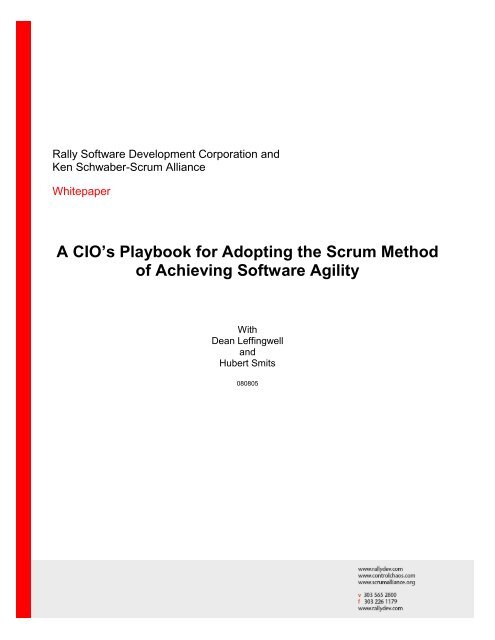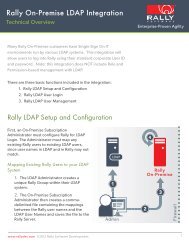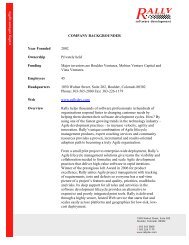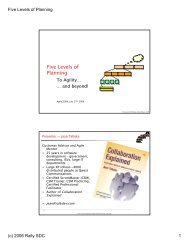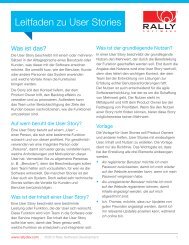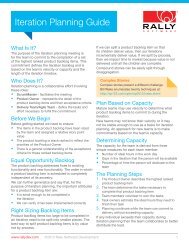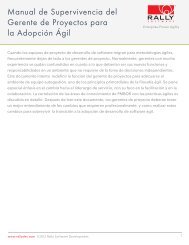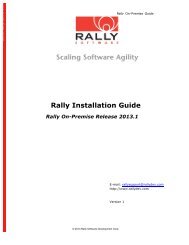A CIO's Playbook for Adopting the Scrum Method of ... - Rally Software
A CIO's Playbook for Adopting the Scrum Method of ... - Rally Software
A CIO's Playbook for Adopting the Scrum Method of ... - Rally Software
Create successful ePaper yourself
Turn your PDF publications into a flip-book with our unique Google optimized e-Paper software.
<strong>Rally</strong> S<strong>of</strong>tware Development Corporation andKen Schwaber-<strong>Scrum</strong> AllianceWhitepaperA CIO’s <strong>Playbook</strong> <strong>for</strong> <strong>Adopting</strong> <strong>the</strong> <strong>Scrum</strong> <strong>Method</strong><strong>of</strong> Achieving S<strong>of</strong>tware AgilityWithDean LeffingwellandHubert Smits080805© 2005 <strong>Rally</strong> S<strong>of</strong>tware Development Corp., Ken Schwaber and <strong>Scrum</strong>Alliance 1
Table <strong>of</strong> ContentsIntroduction .................................................................................................................................................................3Overview <strong>of</strong> <strong>Scrum</strong> and S<strong>of</strong>tware Agility..................................................................................................................4<strong>Scrum</strong> Principles.......................................................................................................................................................5<strong>Scrum</strong> and S<strong>of</strong>tware Agility .....................................................................................................................................7Preparing <strong>for</strong> <strong>Scrum</strong> ...................................................................................................................................................8“<strong>Scrum</strong>ming” both <strong>the</strong> S<strong>of</strong>tware Process and <strong>the</strong> Organization ...............................................................................8The CIO’s Role as Organizational <strong>Scrum</strong>Master <strong>for</strong> Continuous Improvement ....................................................8Caution: Change is Hard Work.................................................................................................................................9A <strong>Playbook</strong> <strong>for</strong> <strong>Adopting</strong> <strong>Scrum</strong>..............................................................................................................................10Play 0 - Overview, Assessment and Pilot Preparation............................................................................................10Play 1 - Pilot Project(s)...........................................................................................................................................11Play 2 - Organizational Expansion .........................................................................................................................11Play 3 – Achieving Impact......................................................................................................................................12Play 4 - Measure, Assess and Adjust......................................................................................................................13Play 5 – Expand and Win .......................................................................................................................................14Organizational Impediments to <strong>Adopting</strong> <strong>Scrum</strong>...................................................................................................15Exposing <strong>the</strong> Impediments with <strong>Scrum</strong> ..................................................................................................................15Characterizing Impediments ...................................................................................................................................15Scaling <strong>Scrum</strong> ............................................................................................................................................................17Scaling <strong>the</strong> Organization: <strong>Scrum</strong> Teams <strong>of</strong> Teams.................................................................................................17Coordinating Teams <strong>of</strong> Teams................................................................................................................................18Tooling Infrastructure <strong>for</strong> Enterprise Agility..........................................................................................................19Summary ....................................................................................................................................................................22Bibliography...............................................................................................................................................................23Appendix A - Resources............................................................................................................................................24Selected Reading ....................................................................................................................................................24Agile Training.........................................................................................................................................................24Agile Tooling and Training ....................................................................................................................................24O<strong>the</strong>r .......................................................................................................................................................................24Possible newsgroups <strong>for</strong> <strong>Scrum</strong> / Agile interested people are: ...............................................................................24Appendix B - The Agile Manifesto...........................................................................................................................25Principles behind <strong>the</strong> Agile Manifesto....................................................................................................................25Deliverables & Change...........................................................................................................................................25People & Communication.......................................................................................................................................25Feedback.................................................................................................................................................................25Credit to agile leaders .............................................................................................................................................25Appendix C - <strong>Scrum</strong> Metrics....................................................................................................................................26Table 1 – <strong>Scrum</strong> Process Metrics (Hartmann, Stallings) ........................................................................................26Table 2 – <strong>Scrum</strong> Project Metrics (<strong>Rally</strong> S<strong>of</strong>tware Development Corp.).................................................................28© 2005 <strong>Rally</strong> S<strong>of</strong>tware Development Corp., Ken Schwaber and <strong>Scrum</strong>Alliance 2
IntroductionThe pressures <strong>of</strong> a truly global economy cause today’s business to increasingly rely on <strong>the</strong>ir ability toproduce s<strong>of</strong>tware as a key competitive advantage. Whe<strong>the</strong>r it be s<strong>of</strong>tware <strong>for</strong> managing manufacturing andcustomer delivery processes or s<strong>of</strong>tware improving <strong>the</strong> efficiency <strong>of</strong> day to day activities, s<strong>of</strong>tware touchesvirtually every facet <strong>of</strong> today’s businesses.And yet <strong>for</strong> many organizations, s<strong>of</strong>tware development practices remain as <strong>the</strong>y were in <strong>the</strong> 1980s. Relianceon prescriptive, plan-based, waterfall methods is common despite mountains <strong>of</strong> evidence that <strong>the</strong>sepractices <strong>of</strong>ten fail to achieve real value delivery in a timely fashion, and so hamper our company’sresponsiveness to fast-changing customer requirements and market conditions. And it’s not getting easier.Today’s IT organizations must also effectively coordinate globally distributed s<strong>of</strong>tware development teamswhile re-factoring legacy applications into more flexible, service oriented architectures. Clearly, we need anew approach <strong>for</strong> managing and developing s<strong>of</strong>tware to remain competitive.Managing distributedorganizations andeffectively migrating toservice orientedarchitectures demanda new s<strong>of</strong>twaredevelopment approachkey to competitive success in <strong>the</strong> marketplace.To address <strong>the</strong>se challenges, a number <strong>of</strong> more agile and adaptive s<strong>of</strong>twaredevelopment techniques are being adopted which allow organizations to deliverhigher quality s<strong>of</strong>tware more quickly. <strong>Scrum</strong> is one such proven method that hasseen widespread adoption in many s<strong>of</strong>tware organizations. This whitepaperdescribes how a CIO or o<strong>the</strong>r executive manager can implement <strong>Scrum</strong> on anorganization-wide basis, including scaling across larger applications and teams <strong>of</strong>teams – <strong>the</strong> challenges he or she will face as well as <strong>the</strong> rewards – and provides aplaybook <strong>for</strong> adopting <strong>Scrum</strong> in enterprises where s<strong>of</strong>tware, and lots <strong>of</strong> it, is <strong>the</strong>This is a “playbook” <strong>of</strong> ideas about implementing <strong>Scrum</strong> within an enterprise. It is called a playbook ra<strong>the</strong>rthan a manual because each organization is unique. <strong>Scrum</strong>’s implementation within one enterprise will besignificantly different from its implementation in ano<strong>the</strong>r. The types <strong>of</strong> impediments, things that needchanging, <strong>the</strong> difficulty <strong>of</strong> change, and <strong>the</strong> people who will be doing <strong>the</strong> changing are different, so <strong>the</strong>timetables, <strong>the</strong> priorities, and <strong>the</strong> ef<strong>for</strong>t will be different as well.© 2005 <strong>Rally</strong> S<strong>of</strong>tware Development Corp., Ken Schwaber and <strong>Scrum</strong>Alliance 3
Overview <strong>of</strong> <strong>Scrum</strong> and S<strong>of</strong>tware AgilityOn <strong>the</strong> surface, <strong>Scrum</strong> is a very simple process: a s<strong>of</strong>tware management technique that has a relativelysmall set <strong>of</strong> interrelated practices and rules, is not overly prescriptive, can be learned quickly and is able toproduce productivity gains almost immediately.<strong>Scrum</strong> naturally focuses an entire organization on building successful products. It delivers useful features atregular intervals as requirements, architecture, and design emerge, even when using unstable technologies.You can implement <strong>Scrum</strong> at <strong>the</strong> beginning <strong>of</strong> a project or in <strong>the</strong> middle <strong>of</strong> a project, and <strong>Scrum</strong> has savedmany development ef<strong>for</strong>ts that were in trouble.<strong>Scrum</strong> works because it optimizes <strong>the</strong> development environment, reduces organizational overhead, andclosely synchronizes market requirements with early feature delivery. Based in modern process control<strong>the</strong>ory, <strong>Scrum</strong> produces <strong>the</strong> best possible s<strong>of</strong>tware given <strong>the</strong> available resources, acceptable quality levels,and required release dates.At its core, <strong>Scrum</strong> is an iterative, incremental process <strong>for</strong> developing any product or managing any work thatproduces a potentially shippable set <strong>of</strong> functionality at <strong>the</strong> end <strong>of</strong> each iteration. <strong>Scrum</strong>’s attributes are:<strong>Scrum</strong> is an agile process to manage and control development work.<strong>Scrum</strong> is a wrapper <strong>for</strong> existing engineering practices.<strong>Scrum</strong> is a team-based approach to developing systems when requirements are changingrapidly.<strong>Scrum</strong> controls <strong>the</strong> chaos <strong>of</strong> conflicting interests and needs.<strong>Scrum</strong> improves communication and maximizes cooperation.<strong>Scrum</strong> detects and removes anything that gets in <strong>the</strong> way <strong>of</strong> developing and delivering products.<strong>Scrum</strong> is a way to maximize productivity.<strong>Scrum</strong> scales from single projects to entire organizations, and has managed development <strong>for</strong>multiple interrelated products and projects with over a thousand team members.<strong>Scrum</strong> is a way <strong>for</strong> everyone to feel good about <strong>the</strong>ir job, <strong>the</strong>ir contributions, and know <strong>the</strong>y havedone <strong>the</strong> very best <strong>the</strong>y possibly could.While describing <strong>Scrum</strong> practices indetail is outside <strong>the</strong> scope <strong>of</strong> thiswhitepaper (see Schwaber 2004and Schwaber 2002), <strong>the</strong> method ischaracterized by <strong>the</strong> production <strong>of</strong> aProduct Backlog where requestedfeatures are organized by <strong>the</strong>irpriority (Figure 1). A Product Owneris responsible <strong>for</strong> approvingchanges to <strong>the</strong> product backlog.Implementation occurs in roughly 30day iterations called Sprints whichfocus on <strong>the</strong> top priorities in <strong>the</strong>Product Backlog. The goal <strong>of</strong> eachSprint is to deliver a potentiallyshippable product increment. DuringFigure 1: An Empirical Process Model thatCharacterizes <strong>Scrum</strong><strong>the</strong> Sprint, checkpoints are observed in a daily “<strong>Scrum</strong>” meeting which communicates <strong>the</strong> progress andactivities within <strong>the</strong> team and shares issues that may be “blocking” progress <strong>for</strong> an individual or <strong>the</strong> team.This allows <strong>the</strong> <strong>Scrum</strong>Master to determine progress against <strong>the</strong> Sprint commitments and advise onmidcourse corrections to assure successful completion <strong>of</strong> <strong>the</strong> Sprint.© 2005 <strong>Rally</strong> S<strong>of</strong>tware Development Corp., Ken Schwaber and <strong>Scrum</strong>Alliance 4
<strong>Scrum</strong> PrinciplesWhile those are some <strong>of</strong> <strong>the</strong> mechanics <strong>of</strong> <strong>Scrum</strong>, more importantly, <strong>the</strong> CIO should understand that <strong>Scrum</strong>is guided by a few key principles:The belief that effective s<strong>of</strong>tware development is best implemented via an empirical ra<strong>the</strong>r thanplanned process;The belief that, once organizational impediments are removed, a self organizing and selfmanaging team will naturally deliver better s<strong>of</strong>tware than would o<strong>the</strong>rwise be <strong>the</strong> case;The premise that you can deliver <strong>the</strong> most valuable s<strong>of</strong>tware within a prescribed time andbudget, and yet you cannot definitively predict <strong>the</strong> exact functionality <strong>of</strong> what a team will deliver.<strong>Scrum</strong>’s assertion is that recognizing <strong>the</strong>se key principles frees an organization from many <strong>of</strong> <strong>the</strong> constraintsthat prevent effective s<strong>of</strong>tware development. However, CIOs must also recognize that <strong>the</strong>se key principlesimply potentially significant change to <strong>the</strong> organization that chooses to adopt <strong>the</strong>m. Since <strong>the</strong>se principles<strong>for</strong>m <strong>the</strong> underlying basis <strong>of</strong> <strong>Scrum</strong>, each merits some additional discussion.<strong>Adopting</strong> an Empirical vs. Planned Process<strong>Scrum</strong> believes that most systems development today has an incorrect philosophical basis, that is, throughmore and better planning we can achieve more predictable, higher quality results. <strong>Scrum</strong> recognizes that <strong>the</strong>applications development process is an unpredictable and extraordinary complicated process (thinkhundreds <strong>of</strong> thousands <strong>of</strong> manually created lines <strong>of</strong> code) whose value can only be measured empirically.After all, <strong>the</strong> application under development has likely not been developed by any team anywhere, ever,much less by your team in your context, so cookbook, step-by-step planning approaches cannot effectivelyaddress <strong>the</strong> inherent unpredictability.<strong>Scrum</strong> defines <strong>the</strong> systems development process as a loose set <strong>of</strong> activities that combines known, workabletools and techniques with an empowered team that is tightly coupled to <strong>the</strong> Customer/Product Owner. Sincemany <strong>of</strong> <strong>the</strong>se activities are loose, controls are applied – such as constant inspection and demonstration –tomanage <strong>the</strong> risk and provide real time, empirical evidence <strong>of</strong> <strong>the</strong> state <strong>of</strong> <strong>the</strong> project at every point in time.The <strong>Scrum</strong> trade<strong>of</strong>f is simple:Know where you are every day with <strong>Scrum</strong>- or -Think you know where you are on your well-<strong>for</strong>med planand discover that you are very wrong, very much later© 2005 <strong>Rally</strong> S<strong>of</strong>tware Development Corp., Ken Schwaber and <strong>Scrum</strong>Alliance 5
Eliminate <strong>the</strong> Impediments So <strong>the</strong> Team Can Do its JobOver <strong>the</strong> years, a company’s organizational processes and s<strong>of</strong>tware development practices typically gainweight until building s<strong>of</strong>tware is <strong>of</strong>ten quite a difficult endeavor. When <strong>Scrum</strong> is implemented, <strong>the</strong>se“organizational impediments” to effective s<strong>of</strong>tware delivery become quite obvious, <strong>for</strong> <strong>the</strong>y get in <strong>the</strong> way <strong>of</strong><strong>the</strong> team’s ability to deliver on <strong>the</strong> rapid iterative, incremental nature <strong>of</strong> <strong>Scrum</strong>. Removing or changing <strong>the</strong>seprocesses and practices may show that a major change project must be initiated, driven and monitored by<strong>the</strong> CIO or executive champion (more on this topic later).Moreover, in <strong>Scrum</strong>, <strong>the</strong> team is <strong>the</strong> thing. After all, <strong>the</strong>y are <strong>the</strong> ones who actually design, develop anddeliver <strong>the</strong> application, so optimizing <strong>the</strong>ir per<strong>for</strong>mance by eliminating obstacles optimizes <strong>the</strong> business’sper<strong>for</strong>mance in delivering value to its users. Management does <strong>the</strong>ir job when <strong>the</strong>y eliminate impediments.The Team does its job when it meets its commitments as described in each Sprint’s Backlog.In o<strong>the</strong>r words, in <strong>Scrum</strong>, <strong>the</strong> team is both empowered and accountable to deliver <strong>the</strong> goods. The team does<strong>the</strong>ir job when <strong>the</strong>y self-organize, self-manage and self-achieve <strong>the</strong> objectives <strong>of</strong> <strong>the</strong> Sprint. For manyorganizations, this turns things upside down. The hierarchical-technical-management-directive approach isessentially eliminated with <strong>Scrum</strong>. The Product Owner now sets <strong>the</strong> objectives and priorities, <strong>the</strong> teamfigures out how to achieve <strong>the</strong>m, and no one need tell <strong>the</strong>m how to do that along <strong>the</strong> way.Better, Though Less Predictable Outcomes vs. False Confidence<strong>Scrum</strong> starts with <strong>the</strong> premise that creating s<strong>of</strong>tware is a complicated business operating in a highly-fluid andtechnical environment, and that no one can reliably predict or definitively plan exactly what a team willdeliver, when <strong>the</strong>y will deliver it, and what <strong>the</strong> quality and cost will be. Instead, <strong>Scrum</strong> understands thatteams can estimate <strong>the</strong>se items, communicate <strong>the</strong> estimates, negotiate a near term plan according tovarious risks and <strong>the</strong>n adjust as <strong>the</strong>y proceed. The agreement is that <strong>the</strong> team will deliver <strong>the</strong> best possibles<strong>of</strong>tware given <strong>the</strong> circumstances, and that following any cookbook approach won't improve <strong>the</strong> definition <strong>of</strong>"best,” and will only hinder <strong>the</strong> team’s responsiveness to <strong>the</strong> real-world complexity and unpredictability thatexists.Historically, ignoring this philosophy creates a number <strong>of</strong> organizational problems:Management actually believes that it can predict <strong>the</strong> cost, delivery schedule, and functionalitythat will be delivered, and plans accordingly.Developers and project managers are <strong>for</strong>ced to live a lie: <strong>the</strong>y pretend <strong>the</strong>y can plan, predict anddeliver. They build one way, but must pretend <strong>the</strong>y build ano<strong>the</strong>r way. In <strong>the</strong> end, <strong>the</strong>y areessentially without controls.By <strong>the</strong> time <strong>the</strong> system is delivered, it is <strong>of</strong>ten irrelevant or requires significant change. A keycause is that high iteration costs limit our visibility into <strong>the</strong> usefulness <strong>of</strong> what <strong>the</strong> team is actuallydeveloping, until it is too late.Recognizing <strong>the</strong>se realities is not without its challenges – <strong>for</strong> example, what manager wants to tell <strong>the</strong>irexecutive <strong>the</strong>y don’t know exactly what <strong>the</strong> team will deliver on <strong>the</strong> given date? But <strong>the</strong> benefits <strong>of</strong> thisapproach are that organizations are truly empowered: <strong>the</strong> business is finally free to produce better outcomes<strong>for</strong> its end users and will now do so more quickly, clearly creating competitive advantage <strong>for</strong> <strong>the</strong> business.© 2005 <strong>Rally</strong> S<strong>of</strong>tware Development Corp., Ken Schwaber and <strong>Scrum</strong>Alliance 6
<strong>Scrum</strong> and S<strong>of</strong>tware Agility<strong>Scrum</strong> has been in use since <strong>the</strong> mid 1990s and has now been applied to thousands <strong>of</strong> projects worldwide.In addition to <strong>Scrum</strong>, several new iterative methodologies have also received attention during this period.Like <strong>Scrum</strong>, each had a combination <strong>of</strong> old ideas and new ideas, but <strong>the</strong>y all emphasized:Close collaboration between <strong>the</strong> development team and business experts;Face-to-face communication (as more efficient than written documentation);Frequent delivery <strong>of</strong> new deployable business value s<strong>of</strong>tware;Tight, self-organizing teams; andWays to craft <strong>the</strong> code and <strong>the</strong> team to allow <strong>for</strong> continuous adaptation to changingrequirements.In 2001, various originators and practitioners <strong>of</strong> <strong>the</strong>se methodologies, including <strong>Scrum</strong> leaders, met tounderstand what it was <strong>the</strong>y had in common. They picked <strong>the</strong> word "agile" <strong>for</strong> an umbrella term and crafted<strong>the</strong> “Manifesto <strong>for</strong> Agile S<strong>of</strong>tware Development” (Appendix B), its most important aspect being a statement <strong>of</strong>shared values:We are uncovering better ways <strong>of</strong> developing s<strong>of</strong>tware by doing it and helping o<strong>the</strong>rs do it.Through this work we have come to value:Individuals and interactions over processes and toolsWorking s<strong>of</strong>tware over comprehensive documentationCustomer collaboration over contract negotiationResponding to change over following a planThat is, while <strong>the</strong>re is value in <strong>the</strong> items on <strong>the</strong> right, we value <strong>the</strong> items on <strong>the</strong> left more.The Manifesto struck a chord and it led to <strong>the</strong> start <strong>of</strong> thousands <strong>of</strong> new agile projects. The results andexperiences <strong>of</strong> <strong>the</strong>se projects fur<strong>the</strong>r enhanced <strong>the</strong> techniques applied by <strong>the</strong> multiple <strong>for</strong>ms <strong>of</strong> agilepractices. As with any human endeavor, some succeeded and some failed. But what was most striking about<strong>the</strong> successes was how much both <strong>the</strong> business people and <strong>the</strong> technical people loved <strong>the</strong>ir project. Thiswas <strong>the</strong> way <strong>the</strong>y wanted s<strong>of</strong>tware development done – and <strong>the</strong> customers and end users agreed.Successful projects spawned more enthusiasts and like a successful Sprint, <strong>the</strong> virtuous agile cyclecontinues today.© 2005 <strong>Rally</strong> S<strong>of</strong>tware Development Corp., Ken Schwaber and <strong>Scrum</strong>Alliance 7
Preparing <strong>for</strong> <strong>Scrum</strong>Once CIOs have a basic understanding <strong>of</strong> <strong>the</strong> business and cultural benefits <strong>of</strong> <strong>Scrum</strong> and agility, <strong>the</strong>y <strong>of</strong>tenwant to take <strong>the</strong> next step and see how this development method can improve <strong>the</strong>ir organization.During its first fifteen years <strong>of</strong> life, most <strong>Scrum</strong> implementations have been driven bottom-up. In o<strong>the</strong>r words,a project team would try <strong>Scrum</strong> and <strong>the</strong> results would be impressive. Ano<strong>the</strong>r team would try it, and prettysoon <strong>Scrum</strong> projects appear throughout <strong>the</strong> organization. More recently, however, many organizations wantto implement <strong>Scrum</strong> top-down as part <strong>of</strong> a directive to speed <strong>the</strong> company’s responsiveness and to improveproductivity.Since <strong>Scrum</strong> is all about team empowerment and “letting <strong>the</strong> team decide,” a top down implementationrequires thoughtful consideration and preparation, as we will describe in this section.“<strong>Scrum</strong>ming” both <strong>the</strong> S<strong>of</strong>tware Process and <strong>the</strong> OrganizationMany organizations have tolerated inefficiencies and impediments <strong>for</strong> years; <strong>Scrum</strong> quickly identifies <strong>the</strong>seand requires <strong>the</strong>ir resolution. Fortunately, <strong>the</strong> increased productivity and value derived from <strong>Scrum</strong> projectsmakes <strong>the</strong> ef<strong>for</strong>t worthwhile, but it is still an ef<strong>for</strong>t.To implement <strong>Scrum</strong>, an organization has to take on two pieces <strong>of</strong> work. Firstly, projects where developmentteams are taught to build s<strong>of</strong>tware using <strong>Scrum</strong>; and, secondly, removing <strong>the</strong> impediments to optimizedcreation and delivery <strong>of</strong> s<strong>of</strong>tware that <strong>the</strong> <strong>Scrum</strong> teams encounter. The first work improves s<strong>of</strong>tware delivery;<strong>the</strong> second remedies impediments to ROI and productivity identified in <strong>the</strong> first.Both pieces <strong>of</strong> work are challenging and require hard work above and beyond <strong>the</strong> actual development <strong>of</strong>s<strong>of</strong>tware; a full <strong>Scrum</strong> implementation may take up to two years. No matter <strong>the</strong> intensity or commitment bymanagement, this timetable cannot be rushed because <strong>the</strong> core <strong>of</strong> <strong>the</strong> project is organizational change.<strong>Scrum</strong>’s daily and monthly inspection and adaptation cycles make everything visible - <strong>the</strong> code, <strong>the</strong> process,and <strong>the</strong> company’s impediments. Projects using <strong>Scrum</strong> regularly identify impediments that must be recorded,evaluated, prioritized, and acted upon.The speed <strong>of</strong> <strong>Scrum</strong> implementation is directly related to <strong>the</strong>:Degree <strong>of</strong> change required within <strong>the</strong> organization;Urgency within <strong>the</strong> organization to improve its s<strong>of</strong>tware development and delivery process;Effectiveness <strong>of</strong> leadership within <strong>the</strong> organization.The CIO’s Role as Organizational <strong>Scrum</strong>Master<strong>for</strong> Continuous ImprovementIn <strong>Scrum</strong>, <strong>the</strong> <strong>Scrum</strong>Master is responsible <strong>for</strong> making sure a <strong>Scrum</strong> team lives by <strong>the</strong> values and practices <strong>of</strong><strong>Scrum</strong>. The <strong>Scrum</strong>Master protects <strong>the</strong> team by making sure <strong>the</strong>y do not over-commit <strong>the</strong>mselves to what<strong>the</strong>y can achieve during a Sprint and <strong>the</strong> <strong>Scrum</strong>Master continuously removes impediments that prevent <strong>the</strong>team from successfully delivering <strong>the</strong> Sprint results.The CIO is <strong>the</strong><strong>Scrum</strong>Master <strong>for</strong>OrganizationalChangeAt <strong>the</strong> organizational-impediment level, this job falls to <strong>the</strong> CIO or o<strong>the</strong>r executivesponsor, whose job it is to work outside <strong>the</strong> team and eliminate <strong>the</strong> organizationalbarriers that may prevent <strong>the</strong> success <strong>of</strong> an agile development model.The job <strong>of</strong> <strong>the</strong> Organizational <strong>Scrum</strong>Master is to notice, identify, and work within <strong>the</strong>organization to cause change that removes impediments. That is, <strong>the</strong> CIO as Organizational <strong>Scrum</strong>Master isprimarily a change agent, and <strong>the</strong> list <strong>of</strong> impediments is <strong>the</strong>ir Product Backlog. The CIO’s <strong>Scrum</strong> sponsor –acting as “Product Owner” <strong>for</strong> <strong>the</strong>se impediments – sets <strong>the</strong> priorities <strong>of</strong> <strong>the</strong>se items. This Product Backlog <strong>of</strong>impediments is worked on by <strong>the</strong> organization through teams using <strong>the</strong> <strong>Scrum</strong> process, with deliverablesbeing impediment removal. This organizational change backlog starts during <strong>the</strong> pilot projects and continuesas long as needed changes are identified during <strong>the</strong> inspect-and-adapt cycle <strong>of</strong> <strong>Scrum</strong>.© 2005 <strong>Rally</strong> S<strong>of</strong>tware Development Corp., Ken Schwaber and <strong>Scrum</strong>Alliance 8
The Organizational <strong>Scrum</strong>Master periodically meets with all <strong>of</strong> <strong>the</strong> <strong>Scrum</strong>Masters, product owner andsponsor to fur<strong>the</strong>r develop <strong>the</strong> Organizational Change Product Backlog. Teams are <strong>for</strong>med that drivechanges to <strong>the</strong> organization within a Sprint. At <strong>the</strong> Sprint Review, <strong>the</strong> change is reviewed as well as <strong>the</strong>metric that can be used to monitor progress in implementing <strong>the</strong> change. In this way, <strong>the</strong> CIO engages in aprocess <strong>of</strong> continued organizational improvement all aimed specifically at increasing <strong>the</strong> productivity andquality <strong>of</strong> <strong>the</strong> s<strong>of</strong>tware development teams.Caution: Change is Hard WorkChange is hard work and <strong>the</strong>re is no way around <strong>the</strong> hard work. Organizations implementing <strong>Scrum</strong>sometimes misidentify <strong>the</strong> hard work as someone’s fault, something that can be made to go away if <strong>the</strong>group at fault would just “clean up <strong>the</strong>ir act”. This type <strong>of</strong> organizational blame can kill a <strong>Scrum</strong>implementation, and with it <strong>the</strong> organization’s ability to build better s<strong>of</strong>tware. When something is painful,when something goes wrong, recognize this is just part <strong>of</strong> <strong>the</strong> change that is occurring; it is an opportunity <strong>for</strong>everyone to get toge<strong>the</strong>r to figure out how to solve <strong>the</strong> problem, toge<strong>the</strong>r.<strong>Scrum</strong> cannot be planned <strong>for</strong> and implemented with checklists, procedures, and <strong>for</strong>ms. <strong>Scrum</strong> is just asimple framework that will identify everything in an organization that gets in <strong>the</strong> way <strong>of</strong> optimally buildings<strong>of</strong>tware. The work to manage and remove <strong>the</strong>se impediments represents <strong>the</strong> difficult part <strong>of</strong> implementing<strong>Scrum</strong>, and it is different <strong>for</strong> every organization, since every organization is different.Nobody likes pain and difficulty; many <strong>of</strong> <strong>the</strong> impediments are so inherent to an organization’s way <strong>of</strong>thinking and operating that <strong>the</strong>y are very difficult to remove. No amount <strong>of</strong> planning up front will mitigate thisdifficulty; it will only help alert everyone to <strong>the</strong> hard work that must be done to become a world-classcompetitor. <strong>Scrum</strong> requires that senior management be vitally involved in impediment triage and removal,and <strong>the</strong>re<strong>for</strong>e requires that <strong>the</strong> CIO adopting <strong>Scrum</strong> become <strong>the</strong> leading agent <strong>for</strong> change.In this way, <strong>the</strong> CIO engages in a process <strong>of</strong> continued organizational improvement, all aimed at increasing<strong>the</strong> productivity and quality <strong>of</strong> <strong>the</strong> s<strong>of</strong>tware teams. It’s not easy, and <strong>the</strong> leadership <strong>the</strong> CIO provides will be acritical factor in success, as <strong>the</strong> following note from Ken Schwaber to a CEO illustrates:From: Ken SchwaberTo: XXX XXXXX, CEO <strong>for</strong> XXXXXXX Corporation“On one hand, <strong>Scrum</strong> <strong>of</strong>fers some very attractive possibilities – increased productivity, a betterworking environment, increased competitiveness, and a higher quality product. On <strong>the</strong> o<strong>the</strong>r hand,it is hard to implement. The amount <strong>of</strong> change engendered by a <strong>Scrum</strong> implementation is significantand difficult.Even though <strong>the</strong> change is difficult <strong>for</strong> <strong>the</strong> developers and customers (product owners), <strong>the</strong>y haveimmediate payback through increased job satisfaction. This helps <strong>the</strong>m through times <strong>of</strong> stress andanxiety. Middle management, however, is stressed without immediate reward. They are asked to helptransition an organization from traditional approaches to leaner approaches without a clear vision<strong>of</strong> a personal end point … what will I do and where will I fit into <strong>the</strong> new organization. Thisquestion is particularly difficult and fraught with danger since middle management will befashioning <strong>the</strong> new organization. The potential <strong>for</strong> conflict and politics is daunting.My experience with top-down, enterprise implementations <strong>of</strong> <strong>Scrum</strong> has led me to believe that <strong>the</strong>differentiator between success and failure is you. Your ability to vision <strong>the</strong> future and helpcommunicate it to your management, your ability to patiently guide <strong>the</strong>m through <strong>the</strong> change, andyour ability to assure your middle management <strong>of</strong> <strong>the</strong>ir value and <strong>for</strong>m <strong>the</strong>m into a team willdifferentiate your ability to absorb <strong>the</strong> change and realize <strong>the</strong> benefits, or not.”© 2005 <strong>Rally</strong> S<strong>of</strong>tware Development Corp., Ken Schwaber and <strong>Scrum</strong>Alliance 9
A <strong>Playbook</strong> <strong>for</strong> <strong>Adopting</strong> <strong>Scrum</strong>Once you decide to implement <strong>Scrum</strong> within your organization, a journey begins with a belief that <strong>the</strong> ef<strong>for</strong>twill be rewarded with a more effective s<strong>of</strong>tware process and a more responsive and competitive company. Italso recognizes that a significant amount <strong>of</strong> organizational change is now in <strong>the</strong> <strong>for</strong>ecast.As <strong>the</strong> CIO contemplates this undertaking, an understanding <strong>of</strong> organizational behavior leads to a rationalset <strong>of</strong> steps <strong>for</strong> achieving substantive change. These include:Finding an evangelist and local sponsor;Taking small initial steps that test <strong>the</strong> waters;Reflecting on successes and failures, <strong>the</strong>n moving <strong>for</strong>ward, step by step.This next section describes some typical examples <strong>of</strong> how you might implement <strong>Scrum</strong> throughout yourorganization; a “playbook” that gives sample techniques you can apply to accomplish <strong>the</strong> requisite change.Play 0 - Overview, Assessment and Pilot PreparationThe objective <strong>of</strong> <strong>the</strong> first play is to prepare <strong>the</strong> playing field <strong>for</strong> <strong>the</strong> activities ahead by a) assessing <strong>the</strong>organizations readiness <strong>for</strong> agility, b) providing initial training <strong>for</strong> <strong>the</strong> early participants and c) building <strong>the</strong>Product Backlog <strong>for</strong> <strong>the</strong> initial projects. The details <strong>of</strong> this play are as follows:Overview and AssessmentDescription: Two day working session consisting <strong>of</strong><strong>Scrum</strong> Aptitude Test – exposes management to <strong>the</strong> types <strong>of</strong> change that happen with<strong>Scrum</strong>, and helps <strong>the</strong>m determine if <strong>the</strong>y want to proceed.<strong>Scrum</strong> presentations – raise general awareness and present concepts to entire organization.Assess organizational readiness and define next steps.Define plans; identify potential pilots, schedule training, and resource <strong>the</strong> pilot project.Dinner with senior management to review next steps.Duration: 2 daysSupport: ExternalPilot PreparationThe organization is ready to proceed with <strong>the</strong> training and structure needed to support <strong>the</strong> first pilot project.Activities in this phase include:<strong>Scrum</strong>Master trainingDescription: Train <strong>Scrum</strong>Masters to run <strong>the</strong> pilotsDuration: 2 daysSupport: ExternalProduct Owner trainingDescription: Train Product Owners to maximize ROI using <strong>Scrum</strong>.Duration: 1 daySupport: External© 2005 <strong>Rally</strong> S<strong>of</strong>tware Development Corp., Ken Schwaber and <strong>Scrum</strong>Alliance 10
Establish MetricsDescription: Review and modify metrics that monitor <strong>the</strong> use <strong>of</strong> <strong>Scrum</strong> within <strong>the</strong> organization anddefine <strong>the</strong> value derived from <strong>the</strong> pilots. Establish core <strong>Scrum</strong> process and project metrics.Duration: 1 weekSupport: ExternalEstablish Change Product BacklogDescription: Establish product backlog <strong>for</strong> tracking and evaluating impediments that arise during <strong>the</strong>pilot projects. This will be <strong>the</strong> basis <strong>for</strong> change action within <strong>the</strong> organization.Duration: 1 daySupport: ExternalPlay 1 - Pilot Project(s)The objective <strong>of</strong> this play is to experience <strong>Scrum</strong> on one or more real projects in order to demonstrate <strong>the</strong>positive benefits <strong>of</strong> improved s<strong>of</strong>tware agility within <strong>the</strong> organization. One or more pilot projects are nowexecuted. <strong>Scrum</strong>Masters and management closely watch <strong>the</strong> pilots to identify organizational obstacles andimpediments to <strong>Scrum</strong>. When <strong>the</strong>se impediments are identified, <strong>the</strong>y are fixed on <strong>the</strong> spot where possible, orare simply recorded in <strong>the</strong> Organizational Change Backlog and categorized <strong>for</strong> later attention.Pilot projectsDuration: 3-6 monthsSupport: External / Internal <strong>Scrum</strong>MasterDescription: Run 3 to 6 iterations <strong>of</strong> <strong>the</strong> pilot projects. Pilot projects deliver increments <strong>of</strong> functionalityand identify impediments to optimized s<strong>of</strong>tware development. Assess and adjust plan, evaluate andprioritize impediments.RetrospectiveRe-planningDuration: 2 daySupport: External / Internal <strong>Scrum</strong>MasterDescription: Review pilot projects, metrics, and impediments. Assess what went right, what could beimproved. Identify <strong>the</strong> ROI. Assess impact on business operations, including relationships withinorganizational departments and with customers.Duration: 1 daySupport: External / Internal <strong>Scrum</strong>MasterDescription: Modify master plan <strong>for</strong> <strong>Scrum</strong> implementation; keep it high level and let project plansand <strong>the</strong> organizational change plan be driven by <strong>the</strong>ir own specific product backlogs.Play 2 - Organizational ExpansionBased on successful pilots, <strong>the</strong> objective <strong>of</strong> this play is to expand <strong>the</strong> usage <strong>of</strong> <strong>Scrum</strong> and its benefits to asignificant subset <strong>of</strong> <strong>the</strong> development organization. By now, <strong>the</strong>re is an understanding <strong>of</strong> what beneficialpractices are embedded, what impediments stand in <strong>the</strong> way <strong>of</strong> broader adoption and where fur<strong>the</strong>r trainingis required. For example, <strong>the</strong> following broader training programs may now be effective:© 2005 <strong>Rally</strong> S<strong>of</strong>tware Development Corp., Ken Schwaber and <strong>Scrum</strong>Alliance 11
<strong>Scrum</strong>Master training: Be<strong>for</strong>e scaling <strong>the</strong> implementation to additional and larger projects youmust be increase <strong>the</strong> number <strong>of</strong> <strong>Scrum</strong> Masters. Candidates with appropriate skills should nowbe recognized in <strong>the</strong> organization. <strong>Scrum</strong>Masters who will be leading <strong>Scrum</strong> <strong>of</strong> <strong>Scrum</strong>s (seebelow) can now be trained in advanced skills like Team Facilitation and Metrics Collection.Product Development Training: We optimize <strong>the</strong> hand-<strong>of</strong>f between analysts and developmentteams when <strong>the</strong>se two roles use a common approach. An <strong>of</strong>ten seen approach is to adopt Leanor Toyota style product development methods. The references list a number <strong>of</strong> books thatprovide in<strong>for</strong>mation on <strong>the</strong>se topics.Engineering Training: The engineering teams involved in agile projects will have learned where<strong>the</strong>y need skills to operate in a more agile manner. Training in Extreme Programming (XP) skillslike Test Drive Development etc. may now be warranted. (Beck 2004)<strong>Scrum</strong>/Agility training: a successful implementation <strong>of</strong> <strong>Scrum</strong> will largely depend on a commonvocabulary <strong>of</strong> all people involved. This can be achieved through 2 – 4 hour introduction courses<strong>for</strong> 30-50% <strong>of</strong> <strong>the</strong> organization.In addition, you may apply o<strong>the</strong>r activities to increase <strong>the</strong> visibility and level <strong>of</strong> acceptance <strong>of</strong> <strong>Scrum</strong> in <strong>the</strong>organization:In<strong>for</strong>mation radiators: Communicate <strong>the</strong> state <strong>of</strong> <strong>Scrum</strong> projects through simple and powerfulin<strong>for</strong>mation radiators, like whiteboards showing <strong>the</strong> tasks (Task Board), Product and ReleaseBacklogs and <strong>the</strong> project and program BurnDown charts.Reading: A suggestion <strong>of</strong> articles and books can be provided to all people in <strong>the</strong> organization toencourage fur<strong>the</strong>r knowledge expansion.CIO led seminars/brownbags: The change leader(s) should communicate <strong>of</strong>ten and openlyabout what is happening in <strong>the</strong> organization. In<strong>for</strong>mal meetings, like brownbags and pizza hourstend to have a positive impact on change.Chats/war stories/feedback from <strong>the</strong> pilot(s): The results from <strong>the</strong> pilot projects should beavailable to everybody. This will increase discussion and involvement through all levels <strong>of</strong> <strong>the</strong>organization.Play 3 – Achieving ImpactAs <strong>the</strong> pilot projects have proven that real value will be delivered through an agile approach to s<strong>of</strong>twareproject management, <strong>the</strong> objective <strong>of</strong> this play is to achieve a more significant impact on <strong>the</strong> bottom linewhich can only be demonstrated through more and larger projects. Through <strong>the</strong> previous plays <strong>the</strong>organization has collected sufficient explicit and tacit knowledge to be able to tackle <strong>the</strong>se with a highprobability <strong>for</strong> success. At this point, as much as 25% <strong>of</strong> <strong>the</strong> organization should be involved in <strong>the</strong>implementation <strong>of</strong> <strong>Scrum</strong>.Effective change should now be occurring inside and outside <strong>the</strong> development organization. Insidedevelopment, <strong>the</strong> work is best done by <strong>the</strong> development team. Outside <strong>the</strong> development teams, <strong>the</strong> work <strong>of</strong>eliminating impediments is directed by <strong>the</strong> Organizational <strong>Scrum</strong>Master and is implemented by <strong>the</strong> affecteddepartments.Development ProjectsDuration: ForeverSupport: InternalDescription: Development projects monitored by ROI.Change ProjectsDuration: Most work in first 1 to 2 years; <strong>the</strong>n, as neededSupport: Internal© 2005 <strong>Rally</strong> S<strong>of</strong>tware Development Corp., Ken Schwaber and <strong>Scrum</strong>Alliance 12
Description: Organizational change projects within various departments drive out emerging andchanging impediments.Assess and AdaptDuration: Every SprintSupport: External / Internal <strong>Scrum</strong>MasterDescription: Review qualitative and quantitative metrics. Add additional metrics and review captureprocesses whenever a surprise has occurred.Play 4 - Measure, Assess and AdjustThe objective <strong>of</strong> this play is to assess <strong>the</strong> organization’s progress and to establish a broader set <strong>of</strong> metrics toserve as a basis <strong>for</strong> fur<strong>the</strong>r expansion. The CIO should be aware that <strong>the</strong> upcoming discussion <strong>of</strong> metricsmay be both controversial and entertaining as many <strong>of</strong> <strong>the</strong> traditional metrics that might be in place prior to<strong>Scrum</strong> adoption (example: measures <strong>of</strong> “document completeness”) are no longer relevant. Fortunately,<strong>Scrum</strong> and agile practices are indeed accountable and measurable and practitioners are converging on a set<strong>of</strong> metrics that provide qualitative and quantitative feedback at both <strong>the</strong> process and project level.But be<strong>for</strong>e entering this discussion, a key distinction needs to be made between many traditional s<strong>of</strong>twaredevelopment processes and <strong>Scrum</strong> and agile:The primary metric <strong>for</strong> agile s<strong>of</strong>tware development is whe<strong>the</strong>r or not working s<strong>of</strong>tware actually exists,and is demonstrably suitable <strong>for</strong> use in its intended purpose. In <strong>Scrum</strong>, that key indicator isdetermined empirically, by demonstration, at <strong>the</strong> end <strong>of</strong> every single Sprint.This primary measure <strong>of</strong> s<strong>of</strong>tware quality and productivity is <strong>the</strong> essence <strong>of</strong> agile development. So with<strong>Scrum</strong>, you cannot be very far <strong>of</strong>f your objective without knowing that you are. All o<strong>the</strong>r metrics aresubordinate to that objective and its constant mantra <strong>of</strong> “delivering working s<strong>of</strong>tware more frequently”.At this point in <strong>the</strong> <strong>Scrum</strong> adoption game, a significant part <strong>of</strong> <strong>the</strong> organization is now operating in an agilemanner. Sprint results <strong>of</strong> <strong>the</strong> initial projects are <strong>the</strong> primary measure <strong>of</strong> <strong>the</strong> effectiveness <strong>of</strong> <strong>the</strong> new teambehaviors and <strong>the</strong>ir new processes. This data should be published and analyzed.Moreover, now is <strong>the</strong> appropriate time to define a set <strong>of</strong> secondary metrics used to guide your organizationon how it implements <strong>Scrum</strong>. In so doing, <strong>the</strong>re are two types <strong>of</strong> metrics that may be applied:Process Metrics – primarily qualitative indicators on <strong>the</strong> effectiveness <strong>of</strong> <strong>the</strong> teams and organizationin adopting <strong>Scrum</strong>. These include items such as effectiveness <strong>of</strong> <strong>the</strong> teams in managing <strong>the</strong> ProductBacklog, effectiveness <strong>of</strong> <strong>Scrum</strong> processes such as <strong>the</strong> <strong>Scrum</strong> daily meeting, Sprint Planningmeeting, etc. In cooperation with <strong>the</strong> <strong>Scrum</strong>Alliance, Hartman and Stallings have developed atemplate <strong>of</strong> process metrics that can be used by any organization that is implementing <strong>Scrum</strong>. Thesemetrics appear as Table 1 in Appendix 2.Project Metrics – At <strong>the</strong> project level, an additional set <strong>of</strong> metrics may be applied to measure <strong>the</strong>results <strong>for</strong> a particular <strong>Scrum</strong> team and <strong>the</strong> service, component or system that <strong>the</strong>y are accountable<strong>for</strong>. These may include some traditional metrics such as defect count, percentage <strong>of</strong> code with unittest coverage, percentage <strong>of</strong> code covered by automated regression tests, etc., as well as <strong>Scrum</strong>specific metrics such as number <strong>of</strong> user stories finished and demonstrable at <strong>the</strong> end <strong>of</strong> each Sprint.An example set <strong>of</strong> <strong>the</strong>se metrics appears as Table 2 in Appendix 2.A Note on Quality and <strong>Scrum</strong>Customers <strong>of</strong>ten pressure development organizations to deliver features faster than is feasible. Someorganizations accommodate this by reducing <strong>the</strong> quality <strong>of</strong> <strong>the</strong> product, dropping re-factoring, cutting testef<strong>for</strong>ts and o<strong>the</strong>r solid engineering practices. This is not supportable within <strong>Scrum</strong> practices since <strong>the</strong> systemor product is a corporate asset, refined continuously and objectively measured, not a one-time project asset.Engineering organizations that succumb to this pressure eventually build “design dead” systems that can notbe effectively maintained or enhanced. The organization suffers <strong>the</strong> huge cost <strong>of</strong> a substantial rewrite and re-© 2005 <strong>Rally</strong> S<strong>of</strong>tware Development Corp., Ken Schwaber and <strong>Scrum</strong>Alliance 13
elease <strong>of</strong> <strong>the</strong> code base. To avoid this, only <strong>the</strong> senior levels <strong>of</strong> an organization can make an asset decision<strong>for</strong> reducing quality.Play 5 – Expand and WinWith <strong>the</strong>se activities behind <strong>the</strong> organization, and with a defined set <strong>of</strong> metrics to guide and evaluate futureprogress on an organization-wide basis, it is now time to expand <strong>the</strong> use <strong>of</strong> <strong>Scrum</strong> across <strong>the</strong> entireorganization. The activities in this phase <strong>of</strong> <strong>the</strong> implementation are focused on <strong>the</strong> fur<strong>the</strong>r scaling <strong>of</strong> <strong>Scrum</strong>within <strong>the</strong> organization.In steps <strong>of</strong> perhaps 25–30% <strong>of</strong> head count, <strong>the</strong> remaining teams in <strong>the</strong> organization are introduced to <strong>Scrum</strong>.Existing practices are fur<strong>the</strong>r refined and shared between <strong>the</strong> teams in order to reach an organizationalinculcation <strong>of</strong> <strong>the</strong> agile practices. Only now can <strong>the</strong> strict rules with which <strong>Scrum</strong> operates be adjusted tobetter match <strong>the</strong> need <strong>of</strong> <strong>the</strong> organization. Customers can be invited to participate in <strong>the</strong> implementationthrough training as product owners or <strong>Scrum</strong>Masters. This phase will continue until all teams are involved in<strong>Scrum</strong>, and <strong>Scrum</strong>’s inspect-and-adapt mechanisms will address fur<strong>the</strong>r enhancement <strong>of</strong> your processesand practices.At this point, <strong>the</strong> organization will be receiving <strong>the</strong> substantial productivity and business and cultural benefits<strong>of</strong> <strong>Scrum</strong>.Be<strong>for</strong>e we proceed to Scaling <strong>Scrum</strong> to <strong>the</strong> largest project environments, however, we need to look at <strong>the</strong>types <strong>of</strong> organizational impediments that can prevent effective <strong>Scrum</strong> practices.© 2005 <strong>Rally</strong> S<strong>of</strong>tware Development Corp., Ken Schwaber and <strong>Scrum</strong>Alliance 14
Organizational Impediments to <strong>Adopting</strong> <strong>Scrum</strong>Applications developed in any organization are intended to optimize <strong>the</strong> ability <strong>of</strong> <strong>the</strong> company to meet itsbusiness mission. However, over <strong>the</strong> course <strong>of</strong> time, organizations evolve in ways which are not alwaysconducive to <strong>the</strong> productivity <strong>of</strong> <strong>the</strong> s<strong>of</strong>tware team that develops and maintains those applications. Indeed,some organizations have evolved to <strong>the</strong> point where <strong>the</strong> s<strong>of</strong>tware practices are largely dysfunctional and –despite repeated ef<strong>for</strong>ts to improve <strong>the</strong>m – <strong>the</strong> organizational structure, policies and strictures preventeffective change. This section describes <strong>the</strong> source and nature <strong>of</strong> <strong>the</strong>se impediments to better arm <strong>the</strong> CIO<strong>for</strong> <strong>the</strong> work ahead.Exposing <strong>the</strong> Impediments with <strong>Scrum</strong>The very nature <strong>of</strong> <strong>Scrum</strong>; its incessant demands <strong>for</strong> quality s<strong>of</strong>tware to be delivered more quickly; itscontinuous demand <strong>for</strong> working with end users to assure effective implementation, and its continuousinspection and adaptation mechanisms expose dysfunctional practices and “blocking issues” very quickly.This effect becomes all <strong>the</strong> more pronounced when <strong>Scrum</strong> is also used as a process to implement and scale<strong>Scrum</strong> in <strong>the</strong> organization.It’s impossible toidentify all <strong>the</strong>organizationalef<strong>for</strong>ts up frontYou cannot identify all impediments up front as <strong>the</strong>y are embedded in <strong>the</strong> organizationand <strong>the</strong>re<strong>for</strong>e too familiar to be identified easily. Only when you start using <strong>Scrum</strong> do<strong>the</strong>y become obvious. The plan <strong>for</strong> implementation emerges as <strong>the</strong> evidence <strong>of</strong> whatneeds to be changed and <strong>the</strong> organization's willingness to make <strong>the</strong> change emerges.Characterizing ImpedimentsImpediments will generally be encountered in four areas:<strong>Scrum</strong> Process Itself – what impediments are occurring that get in <strong>the</strong> way <strong>of</strong> <strong>the</strong> <strong>Scrum</strong> process?People Practices – what people practices are getting in <strong>the</strong> way <strong>of</strong> developing, distributing,supporting and using products to maximize <strong>the</strong> fulfillment <strong>of</strong> everyone involved?Product Engineering Practices – what practices are impeding <strong>the</strong> optimization <strong>of</strong> return oninvestment, or maximizing <strong>the</strong> mission <strong>of</strong> <strong>the</strong> organization from a product perspective, and whatimpediments are <strong>the</strong>re to optimized product development and delivery?Organizational Issues – what systemic organizational issues - that lie clearly outside <strong>the</strong> team’scontrol - are preventing <strong>the</strong> teams from delivering s<strong>of</strong>tware to its users more quickly?We want separate categories in <strong>the</strong> Organizational Impediment Product Backlog because <strong>the</strong>se requireunique skills to resolve. In addition, <strong>the</strong>y should be prioritized as to impact, and some thought should begiven as to who best in <strong>the</strong> organization can best resolve <strong>the</strong> impediment.Table 1 below shows examples <strong>of</strong> impediments found in organizations adopting <strong>Scrum</strong>. This list mightprovide a starting point and an early warning system <strong>for</strong> some <strong>of</strong> <strong>the</strong> impediments your organization is likelyto encounter. But again, every company is different and every implementation is different, so <strong>for</strong>tunately orun<strong>for</strong>tunately, <strong>the</strong> <strong>Scrum</strong> process will assuredly discover some new impediments <strong>for</strong> <strong>the</strong> CIO to deal with!© 2005 <strong>Rally</strong> S<strong>of</strong>tware Development Corp., Ken Schwaber and <strong>Scrum</strong>Alliance 15
Impact Cost Owner<strong>Scrum</strong> ProcessPeople arrive late to daily <strong>Scrum</strong> and do not support basic discipline<strong>Scrum</strong> meetings take too long – team is bored and considers <strong>the</strong> time unproductive<strong>Scrum</strong>Master dictates design decisions or micromanagesTeams are too large <strong>for</strong> effective daily <strong>Scrum</strong> and Sprint planningTeams do not report task remaining time <strong>for</strong> BurnDown analysisPeople PracticesIndividuals interrupted and tasked to work outside <strong>the</strong> SprintTeams isolated in cubicle and not in open <strong>Scrum</strong> areaTeam members not accountable <strong>for</strong> personal Sprint commitmentsIndividuals are multiplexed across too many projects and teamsProduct Engineering PracticesCross-functional resources <strong>for</strong> definition, design, implementation and test are not present on <strong>the</strong>teamSprints do not fully implement and test potentially deployable increments <strong>of</strong> customer valuedfeaturesProduct owner not easily available/not integral to teamSystem integration is not <strong>for</strong>ced at each SprintProduct owner won’t split up massive product backlog items to fit within a Sprint.Teams have ineffective resources <strong>for</strong> automating builds and integrationsFeatures loaded into Sprint after Sprint beginsOrganizational IssuesS<strong>of</strong>tware process police regulate to ineffective processesManagement assumes fixed price, fixed time, fixed functionality delivery postureS<strong>of</strong>tware Test/and or System QA is separate organization and is not integrated with teamOrganization rewards individual, ra<strong>the</strong>r than team behaviorExisting rules or s<strong>of</strong>tware capitalization demand adherence to document-driven, waterfallapproachesTeams not co-located to maximum extent feasibleTeams cannot make small organizational, space and expense decisions needed to do <strong>the</strong>ir jobLegend:Impact <strong>of</strong> this impediment to <strong>the</strong> project (0-9, 0 low, 9 high),Cost to resolve this impediment (0-9, 0 low, 9 high)Owner: Point in an organization <strong>for</strong> resolution: C – CEO/CTO/COO/CFO, V – VP, D – Director., P – ProductManagement, E – Engineering Management, T – Team© 2005 <strong>Rally</strong> S<strong>of</strong>tware Development Corp., Ken Schwaber and <strong>Scrum</strong>Alliance 16
Scaling <strong>Scrum</strong>The business benefits <strong>of</strong> <strong>Scrum</strong> and agility are most readily achieved with small, co-located and integratedteams, ideally consisting <strong>of</strong> eight people or less (including Product Owner, <strong>Scrum</strong>Master, Developers andTesters) and where each <strong>Scrum</strong> team owns a specific product or application that <strong>the</strong>y can define, develop,test and deliver without much outside help.Inevitably, however, <strong>the</strong> success <strong>of</strong> <strong>Scrum</strong> will lead to its application to larger programs, systems <strong>of</strong> systems,and applications that take many, likely distributed, teams to develop and deliver. Fortunately, <strong>Scrum</strong> hasbeen proven in projects consisting <strong>of</strong> many hundreds <strong>of</strong> developers so <strong>Scrum</strong> does scale to <strong>the</strong> challenge <strong>of</strong><strong>the</strong> larger s<strong>of</strong>tware enterprise. Doing so, however, brings about a unique set <strong>of</strong> challenges that must beaddressed, specifically:1. Scaling <strong>the</strong> organization: <strong>Scrum</strong> teams <strong>of</strong> teams2. Tooling infrastructure <strong>for</strong> enterprise agility3. Coordinating teams <strong>of</strong> teamsEach <strong>of</strong> <strong>the</strong>se challenges is addressed in <strong>the</strong> sections below.Scaling <strong>the</strong> Organization: <strong>Scrum</strong> Teams <strong>of</strong> TeamsConsistent with its less is more philosophy, <strong>Scrum</strong> has a very small number <strong>of</strong> rules. However, most <strong>of</strong> <strong>the</strong>rules that do exist are fixed and relatively inviolate. One basic rule is <strong>the</strong> team consists <strong>of</strong> eight or fewermembers that are co-located in a common seating area. This is <strong>the</strong> most effective and productive model as ita) supports <strong>the</strong> requirement <strong>for</strong> constant in<strong>for</strong>mal communication amongst <strong>the</strong> team members, b) fosters ahigh degree <strong>of</strong> esprit de corps and c) allows <strong>for</strong> a mutual commitment to <strong>the</strong> goals <strong>of</strong> <strong>the</strong> Sprint amongstteam members who actually know each o<strong>the</strong>r and have to work toge<strong>the</strong>r every day. In addition, certain<strong>Scrum</strong> mechanisms, such as Sprint planning and <strong>the</strong> Daily <strong>Scrum</strong> meeting can breakdown very quickly as<strong>the</strong> team size gets beyond 8-10 individuals.Scaling <strong>Scrum</strong> to larger applications leaves this key principle in place. So, scaling to an application involving300 people involves organizing around 30 <strong>Scrum</strong> teams. As previously discussed, <strong>the</strong> team’s complementmust be fully rounded and capable <strong>of</strong> developing potentially shippable pieces <strong>of</strong> functionality at every Sprint.For most organizations, this requires reorganizing teams around product features, services, components orsubsystems, ra<strong>the</strong>r than by individual role (e.g. developer pool, test resources, etc.). While we discussed thisorganizational impediment earlier, we see it gets compounded as our project’s size increases.Organization Follows ArchitectureMoreover, we cannot readily <strong>for</strong>m <strong>Scrum</strong> teamswithout understanding how each individual teamcan relatively holistically deliver end userfunctionality. In turn, this mandates that wedecompose <strong>the</strong> application architecture intocomponents or subsystems that have conceptualintegrity and can deliver business value on <strong>the</strong>irown 1 . <strong>Scrum</strong> provides <strong>for</strong> this architecturalfactoring activity in <strong>the</strong> Sprint staging phase, and inearly Sprints, by <strong>the</strong> front-running <strong>Scrum</strong> teams.This method works particularly well in a period <strong>of</strong><strong>Scrum</strong> expansion and rollout <strong>for</strong> a large project.Here, <strong>the</strong> front-running teams build pro<strong>of</strong> points <strong>of</strong>customer value while <strong>the</strong>y simultaneously factorFigure 2: A System Being Built by Three <strong>Scrum</strong> TeamsOver Three Sprints1 This level <strong>of</strong> sharing and communication can indeed be a challenge when implementing service oriented architectures, as <strong>the</strong>existing organization likely mirrors <strong>the</strong> prior architecture <strong>of</strong> independent silos <strong>of</strong> applications whose department owners were notoverly-required to cooperate to deliver more flexible services to users, as now becomes <strong>the</strong> case.© 2005 <strong>Rally</strong> S<strong>of</strong>tware Development Corp., Ken Schwaber and <strong>Scrum</strong>Alliance 17
<strong>the</strong> application architecture to accept additional teams, whose <strong>Scrum</strong> training will likely be occurring at about<strong>the</strong> same time. As each new team is <strong>for</strong>med, its role in <strong>the</strong> larger system becomes clear and a picture likeFigure 2 emerges.Coordinating Teams <strong>of</strong> TeamsOf course, <strong>the</strong> presence <strong>of</strong> a large number <strong>of</strong> teams brings significant challenges in coordinating andcommunicating across teams, and also implies that <strong>the</strong>re will likely be a number <strong>of</strong> issues at <strong>the</strong> system levelwhich require <strong>the</strong> same daily and monthly inspection practices applied at <strong>the</strong> local team level. Experienceswith scaling <strong>Scrum</strong> to larger teams have evolved a small set <strong>of</strong> useful practices <strong>for</strong> coordinating disparateteams and addressing <strong>the</strong> larger challenges <strong>of</strong> Sprint planning, release planning and tracking system levelintegration and test activities.Daily Communication: <strong>Scrum</strong> <strong>of</strong> <strong>Scrum</strong>sIn <strong>the</strong> same fashion that <strong>Scrum</strong> mandates daily communication in <strong>the</strong> daily <strong>Scrum</strong>, larger and distributedteams typically coordinate <strong>the</strong>ir activities in a daily <strong>Scrum</strong> <strong>of</strong> <strong>Scrum</strong>s. In this meeting, team leaders fromeach component team use <strong>the</strong> same <strong>for</strong>mat as <strong>the</strong> single team daily meeting:1. What did my team do yesterday to advance <strong>the</strong> objectives <strong>of</strong> <strong>the</strong> Sprint?2. What will my team do today?3. What impediments are present that could keep my team from meeting its commitment to <strong>the</strong>Sprint?Ideally, this meeting occurs immediately after <strong>the</strong> individual team’s daily <strong>Scrum</strong>. When teams are dispersed,it <strong>of</strong>ten occurs by telephone with <strong>the</strong> time <strong>of</strong> day selected to maximize participation amongst <strong>the</strong> scrum <strong>of</strong>scrum team members.System Level Release Planning and TrackingFigure 2 might imply that it is a fairly straight<strong>for</strong>ward matter to divide <strong>the</strong> organization into feature, service orsubsystem teams, empower <strong>the</strong>se teams to do <strong>the</strong>ir jobs, and that a wonderfully integrated system willnaturally occur. Experience has shown that this isunlikely. For even when <strong>the</strong> individual teams areempowered to meet both <strong>the</strong> needs <strong>of</strong> <strong>the</strong> Sprintand coordinate integration between <strong>the</strong>teams/subsystems, a larger set <strong>of</strong> challenges ispresent. That is <strong>the</strong> challenge <strong>of</strong> building a systemholistically, where we implement ant test ourintegrations across all subsystems, wheresubsystems work toge<strong>the</strong>r to meet broadercustomer requirements and that <strong>the</strong> overall systemmeets its quality, per<strong>for</strong>mance and reliabilityrequirements.To address <strong>the</strong>se challenges, many teams haveadded a technical lead role played at <strong>the</strong> systemlevel. Architects, team leads, product managersand quality assurance personnel will <strong>of</strong>ten growinto an additional <strong>Scrum</strong> team to think and act at<strong>the</strong> system level. Moreover, <strong>the</strong>y can also apply<strong>the</strong> <strong>Scrum</strong> process at <strong>the</strong> system level to set Sprintobjectives and create backlog items <strong>of</strong> <strong>for</strong>cedsystem integrations, system level demonstrations,quality checkpoints, trial distributions and o<strong>the</strong>rmilestones to assure that <strong>the</strong> system stays on track.In so doing, <strong>the</strong> picture in Figure 3 starts to emerge.Figure 3: System <strong>of</strong> Three Subsystems withSystem Level Sprints© 2005 <strong>Rally</strong> S<strong>of</strong>tware Development Corp., Ken Schwaber and <strong>Scrum</strong>Alliance 18
Tooling Infrastructure <strong>for</strong> Enterprise AgilityEven with this level <strong>of</strong> structure and coordination, larger projects and distributed teams may still find<strong>the</strong>mselves lacking <strong>the</strong> internal and cross-team coordination and project visibility required to reliably delivers<strong>of</strong>tware in rapid, fully-tested iterations. While <strong>Scrum</strong> provides a proven framework <strong>for</strong> <strong>the</strong> projectmanagement aspects <strong>of</strong> s<strong>of</strong>tware development, it does not prescribe specific s<strong>of</strong>tware engineering practicesnor recommend specific tooling to support <strong>the</strong> <strong>Scrum</strong> process. <strong>Scrum</strong>’s philosophy in this regard is “keep itsimple and let <strong>the</strong> teams decide.”Indeed, <strong>for</strong> <strong>the</strong> ideal team <strong>of</strong> less than ten co-located persons, <strong>the</strong> prime project management artifacts usedto plan <strong>the</strong> Sprint and communicate status <strong>of</strong> individual features, tasks and team progress can <strong>of</strong>ten bemanaged using a spreadsheet developed and maintained by <strong>the</strong> <strong>Scrum</strong>Master. The engineering artifacts <strong>for</strong>requirements, test cases and defects may be equally lightweight and written on index cards, whiteboards ormaintained on a team wiki.People and CommunicationHowever, scaling <strong>Scrum</strong> practices to distributed teams, and teams <strong>of</strong> teams, presentsScaling <strong>Scrum</strong> special communication challenges. Cross-team coordination <strong>of</strong> how to implementpresents specialshared requirements, track feature status and identify blocking issues becomes atooling challengesprimary concern. In <strong>the</strong>se cases “a mechanism <strong>for</strong> frequently synchronizing <strong>the</strong>ir workmust be devised and implemented. Also, a more detailed product and technicalarchitecture must be constructed so <strong>the</strong> work can be cleanly divided across teams.” (Schwaber 2004)While traditional project management tools may have worked <strong>for</strong> showing idealized task start/stop dates andper<strong>for</strong>ming - perhaps fruitless - critical path analysis on long waterfall projects, <strong>the</strong>se plan-driven activitieslose <strong>the</strong>ir relevance when working in short iterations where <strong>the</strong> entire team focuses on driving <strong>the</strong> fewhighest priority features to acceptance. Instead <strong>of</strong> one person maintaining a separate task database that isdecoupled from <strong>the</strong> day-to-day artifacts <strong>the</strong> team is actually planning and implementing (e.g. user stories andtests), larger programs need a real-time collaboration environment that supports <strong>the</strong> natural signalingoccurring among team members as <strong>the</strong>y advance a feature from <strong>the</strong> Product Backlog into development,testing and integration. To emulate <strong>the</strong> co-located team, this agile project management environment must leteveryone quickly see and update where a feature is in its lifecycle, how much ef<strong>for</strong>t remains be<strong>for</strong>e itscompletion and what specific issues are blocking its progress.Besides needing new ways to plan and track our iterations, <strong>the</strong> capabilities <strong>of</strong> tools applied to defining,organizing and sharing our system artifacts have new demands as well. Managing requirements, <strong>the</strong>iracceptance tests and defects calls <strong>for</strong> support that is horizontal across <strong>the</strong> lifecycle activities inside a Sprint,not vertical with deep silos <strong>of</strong> artifact in<strong>for</strong>mation that are poorly related to <strong>the</strong> commitments <strong>the</strong> teams havemade. In fact, with rapid iterations, it is really <strong>the</strong> relationships between <strong>the</strong>se artifacts that are <strong>the</strong> primaryconcern to <strong>the</strong> teams. After all, each Sprint is producing many pieces <strong>of</strong> working, tested code, so <strong>the</strong> teamsmust understand exactly how <strong>the</strong>se engineering artifacts relate to each o<strong>the</strong>r and be able to see <strong>the</strong>ir statusat every point in time.© 2005 <strong>Rally</strong> S<strong>of</strong>tware Development Corp., Ken Schwaber and <strong>Scrum</strong>Alliance 19
Tooling Infrastructure OpportunitiesBeing s<strong>of</strong>tware developers after all, <strong>the</strong> teams will naturally want to better organize <strong>the</strong>ir artifacts andautomate those aspects <strong>of</strong> <strong>the</strong> <strong>Scrum</strong> process that lend <strong>the</strong>mselves to s<strong>of</strong>tware support. Specifically, <strong>the</strong>teams will likely want to add infrastructure support <strong>for</strong> <strong>the</strong> following activities and artifact types in <strong>the</strong> s<strong>of</strong>twarelifecycle:Backlog Management – As system complexity grows, <strong>the</strong> team will want better support <strong>for</strong>capture and maintenance <strong>of</strong> <strong>the</strong> feature lists, functional and nonfunctional requirements, usecases, and user stories as well as <strong>the</strong> priorities, estimates, status and owners <strong>of</strong> <strong>the</strong>se items. As<strong>Scrum</strong> is applied to larger projects, <strong>the</strong>se artifacts may grow to many thousands in count and ameans to organize, support and view <strong>the</strong>m by system or subsystem becomes critical.Project Reporting – <strong>Scrum</strong> eschews traditional, waterfall-like project plans, but <strong>the</strong> tactical dayto day project management nature <strong>of</strong> <strong>Scrum</strong> is intense and unremitting. The team will need asimple way <strong>for</strong> each member to enter <strong>the</strong>ir task estimates, status, and ef<strong>for</strong>t remaining so that<strong>the</strong> BurnDown Charts are automated and continuously available. In addition, <strong>the</strong> infrastructureshould support <strong>the</strong> natural signaling teams use as backlog items move through <strong>the</strong>ir lifecycle.Senior personnel will need to look across teams and understand <strong>the</strong>ir individual iterations andrelease plans in order to asses <strong>the</strong> status <strong>of</strong> <strong>the</strong>ir program as a whole.Just-in-Time Requirements Elaboration – Many smaller <strong>Scrum</strong> projects succeed with in<strong>for</strong>malrequirements mechanisms such as direct discussion between <strong>the</strong> Product Owner and Team, butas project complexity and criticality grows, more depth and richness <strong>of</strong> requirements expressionand requirements versioning will likely be required. For example, documentation <strong>of</strong> interfacesthat affect multiple teams becomes critical. Changes to interfaces or new features that crossteam boundaries may have a significant impact on <strong>the</strong> project. These requirements should beelaborated on a just-in-time basis, meaning at, or just prior to <strong>the</strong> Sprint that implements <strong>the</strong> newfunctionality. To address this problem, teams may want centralized support <strong>for</strong> richer <strong>for</strong>ms <strong>of</strong>requirements expression, <strong>the</strong>ir compilation <strong>for</strong> review and automated change notification.Early Testing: Since every Sprint delivers potentially shippable code into <strong>the</strong> product baseline,early test case development and test automation enables teams to support <strong>the</strong> rapid iterationrequirements <strong>of</strong> <strong>Scrum</strong>. Tooling that generates test cases directly from requirements or storycards will accelerate <strong>the</strong> development process and provide <strong>the</strong> inherent traceability needed toprove acceptance <strong>of</strong> <strong>the</strong> feature. Know that <strong>the</strong> ongoing management <strong>of</strong> <strong>the</strong> hundreds andthousands <strong>of</strong> regression tests that accrue will likely become <strong>the</strong> critical factor in determining <strong>the</strong>speed and success <strong>of</strong> your Sprints.Release Planning – The philosophy <strong>of</strong> <strong>Scrum</strong> focuses on <strong>the</strong> “art <strong>of</strong> <strong>the</strong> possible in <strong>the</strong> nearerterm”, as opposed to <strong>the</strong> black art <strong>of</strong> supposedly predicting exactly what will be delivered 6-12Sprints down <strong>the</strong> road. This philosophy is a breakthrough in thinking at <strong>the</strong> team level because itallows <strong>Scrum</strong> teams to focus in a “heads down” fashion <strong>for</strong> 30 days at a time, and thus produceworking s<strong>of</strong>tware more reliably. But as <strong>the</strong> teams grow and scale, applying additional analysisand rigor to Sprints beyond <strong>the</strong> immediate horizon helps avoid architectures that requiresubstantial re-factoring down <strong>the</strong> road. While re-factoring is highly encouraged in agile, itbecomes less practical as <strong>the</strong> scope <strong>of</strong> <strong>the</strong> application and <strong>the</strong> number <strong>of</strong> existing deploymentsincreases. Additional release planning that provides us with architectural runway is <strong>of</strong>tenappropriate. There<strong>for</strong>e, <strong>the</strong> art <strong>of</strong> Sprint planning can include “a few Sprints out” and “what-if”planning functions that help <strong>the</strong> teams make backlog trade<strong>of</strong>fs and communicate a reasonablevision and product roadmap to <strong>the</strong> sponsors.In addition, <strong>the</strong>se teams will typically want to organize all <strong>the</strong>se assets in a central repository where everyteam member can access <strong>the</strong>m, 24x7, worldwide, and one which provides instantaneous views <strong>of</strong> projectand program status, with automated change notification <strong>for</strong> critical project changes.© 2005 <strong>Rally</strong> S<strong>of</strong>tware Development Corp., Ken Schwaber and <strong>Scrum</strong>Alliance 20
Evolving <strong>the</strong> Infrastructure in SprintsIn <strong>Scrum</strong>, deploying this level <strong>of</strong> infrastructure is not a one time event, done “up front” by a tooling team.Instead, <strong>the</strong> <strong>Scrum</strong> teams <strong>the</strong>mselves take on <strong>the</strong> task <strong>of</strong> identifying what <strong>the</strong>y will buy and build to address<strong>the</strong>ir problems based on <strong>the</strong> lessons learned in prior Sprints. Moreover, <strong>the</strong>se investments are made in <strong>the</strong>context <strong>of</strong> ongoing Sprints. There<strong>for</strong>e <strong>the</strong> team addresses <strong>the</strong> build out <strong>of</strong> infrastructure by adding items to<strong>the</strong> Product Backlog to address <strong>the</strong> infrastructure items as per Figure 4 below. Of course, customer facingfunctionality still takes priority, but <strong>the</strong> experienced team recognizes <strong>the</strong>y must be able to continuouslyschedule infrastructure work as well in order to maintain <strong>the</strong>ir velocity and productivity as <strong>the</strong> applicationscope and number <strong>of</strong> teams grows.Figure 4: Parsing Scalability Infrastructure into a Sprint© 2005 <strong>Rally</strong> S<strong>of</strong>tware Development Corp., Ken Schwaber and <strong>Scrum</strong>Alliance 21
Summary<strong>Scrum</strong> is a proven and effective s<strong>of</strong>tware development practice that can rapidly increase <strong>the</strong> productivity,delivery speed and quality <strong>of</strong> s<strong>of</strong>tware teams.What IT organization would not benefit from <strong>the</strong>se attributes commonly experienced by successful <strong>Scrum</strong>implementations?Decreased development cycle timesHigher value throughput to end usersHigher qualityLower development riskGreater user satisfactionImproved company moraleWhile appearing simple on <strong>the</strong> surface, implementing <strong>Scrum</strong> <strong>of</strong>ten requires substantial organizational changeto eliminate <strong>the</strong> impediments to effective development and delivery. As lead change agent, <strong>the</strong> CIO or o<strong>the</strong>rexecutive sponsor has <strong>the</strong> primary responsibility <strong>for</strong> eliminating <strong>the</strong>se impediments. It is <strong>the</strong> enduringcommitment by <strong>the</strong> CIO that may well be <strong>the</strong> difference between success and failure <strong>of</strong> <strong>the</strong> implementation.While none <strong>of</strong> this is easy, <strong>the</strong> CIO who commits to improving s<strong>of</strong>tware outcomes with <strong>Scrum</strong> will take <strong>the</strong>first step in ensuring that <strong>the</strong> enterprise is well on its way to achieving <strong>the</strong> business benefits <strong>of</strong> faster andbetter quality s<strong>of</strong>tware delivery.In addition, <strong>Scrum</strong> is highly effective in large-scale enterprise application development and can support <strong>the</strong>needs <strong>of</strong> many hundreds <strong>of</strong> developers working on shared applications. Scaling <strong>Scrum</strong> presents anadditional set <strong>of</strong> challenges to infrastructure and tooling that <strong>the</strong> teams <strong>the</strong>mselves will address – butovercoming <strong>the</strong>se challenges will likely deliver a substantial advantage to <strong>the</strong>se larger organizations over<strong>the</strong>ir marketplace rivals.© 2005 <strong>Rally</strong> S<strong>of</strong>tware Development Corp., Ken Schwaber and <strong>Scrum</strong>Alliance 22
BibliographyAgile Manifesto: www.agilealliance.orgBeck, Kent. Extreme Programming Explained: Embrace Change (2nd Edition). Boston: Addison-Wesley,2004.Schwaber. Ken. Agile Project Management with <strong>Scrum</strong>. Redmond, WA: Micros<strong>of</strong>t Press, 2004.Schwaber, Ken, and Mike Beedle. Agile S<strong>of</strong>tware Development with <strong>Scrum</strong>. Upper Saddle River, N.J.:Prentice Hall, 2002.© 2005 <strong>Rally</strong> S<strong>of</strong>tware Development Corp., Ken Schwaber and <strong>Scrum</strong>Alliance 23
Appendix A - ResourcesSelected ReadingBeck, Kent. Extreme Programming Explained: Embrace Change 2nd Edition. Boston: Addison-Wesley, 2004.Cockburn, Alistair. Agile S<strong>of</strong>tware Development. Boston: Addison-Wesley, 2002.Cohn, Mike. User Stories Applied. Boston, MA: Pearson Education, 2004.Highsmith, Jim. Agile Project Management: Creating Innovative Products. Boston: Pearson Education, 2004.Nonaka, Ikujiro and Hirotaka Takeuchi. The Knowledge-Creating Company. Ox<strong>for</strong>d University Press, 1995.Poppendieck, Mary and Tom Poppendieck. Lean S<strong>of</strong>tware Development. Addison-Wesley, 2003.Schwaber. Ken. Agile Project Management with <strong>Scrum</strong>. Redmond, WA: Micros<strong>of</strong>t Press, 2004.Schwaber, Ken, and Mike Beedle. Agile S<strong>of</strong>tware Development with <strong>Scrum</strong>. Upper Saddle River, N.J.: Prentice Hall, 2002.Larman, Craig. Agile and Iterative Development: A Manager’s Guide, Boston: Addison Wesley 2004Agile TrainingSCRUM Master Class - www.controlchaos.com/certifiedscrum/EXtreme Programming - www.xprogramming.com/xpmag/services.htmAgile Tooling and Training<strong>Rally</strong> S<strong>of</strong>tware Development: www.rallydev.comO<strong>the</strong>rAgile Alliance: www.agilealliance.org<strong>Scrum</strong>Alliance: http://www.scrumalliance.org/Possible newsgroups <strong>for</strong> <strong>Scrum</strong> / Agile interested people are:<strong>Scrum</strong> Development: http://groups.yahoo.com/group/scrumdevelopment/Agile Management: http://groups.yahoo.com/group/agilemanagement/Agile Testing: http://groups.yahoo.com/group/agile-testingLean development: http://groups.yahoo.com/group/leandevelopment/© 2005 <strong>Rally</strong> S<strong>of</strong>tware Development Corp., Ken Schwaber and <strong>Scrum</strong>Alliance 24
Appendix B - The Agile ManifestoIn 2001, a workshop was held in Snowbird, Utah, USA, where various originators and practitioners <strong>of</strong> agile methodologies met tounderstand what <strong>the</strong>y had in common. They picked <strong>the</strong> word "agile" <strong>for</strong> an umbrella term and crafted <strong>the</strong> Manifesto <strong>for</strong> Agile S<strong>of</strong>twareDevelopment, whose underpinning are a statement <strong>of</strong> shared values:“We are uncovering better ways <strong>of</strong> developing s<strong>of</strong>tware by doing it and helping o<strong>the</strong>rs do it. Through this work we have come tovalue:Individuals and interactions over processes and toolsWorking s<strong>of</strong>tware over comprehensive documentationCustomer collaboration over contract negotiationResponding to change over following a planThat is, while <strong>the</strong>re is value in <strong>the</strong> items on <strong>the</strong> right, we value <strong>the</strong> items on <strong>the</strong> left more.”The Manifesto struck a chord, and it led to many new agile projects being started. As with any human endeavor, some succeeded andsome failed. But what was striking about <strong>the</strong> successes was how much both <strong>the</strong> business people and <strong>the</strong> technical people loved <strong>the</strong>irproject. This was <strong>the</strong> way <strong>the</strong>y wanted s<strong>of</strong>tware development done. Successful projects spawned enthusiasts.Principles behind <strong>the</strong> Agile ManifestoThe Agile Manifesto signatories agreed on twelve principles that underwrite and re-en<strong>for</strong>ce <strong>the</strong> manifesto. These principles focus ondeliverables and change, people & communication and feedback:Deliverables & ChangeInstead <strong>of</strong> prescribing or advising on large number <strong>of</strong> artifacts that should be delivered as <strong>the</strong> result <strong>of</strong> a successful project completion,agile methods go back to <strong>the</strong> principle deliverable: working s<strong>of</strong>tware.Working s<strong>of</strong>tware is <strong>the</strong> primary measure <strong>of</strong> progress.Our highest priority is to satisfy <strong>the</strong> customer through early and continuous delivery <strong>of</strong> valuable s<strong>of</strong>tware.Deliver working s<strong>of</strong>tware frequently, from a couple <strong>of</strong> weeks to a couple <strong>of</strong> months, with a preference to <strong>the</strong> shortertimescale.Welcome changing requirements, even late in development. Agile processes harness change <strong>for</strong> <strong>the</strong> customer'scompetitive advantage.The best architectures, requirements, and designs emerge from self-organizing teams.Simplicity -<strong>the</strong> art <strong>of</strong> maximizing <strong>the</strong> amount <strong>of</strong> work not done- is essential.Continuous attention to technical excellence and good design enhances agility.People & CommunicationBuilding working s<strong>of</strong>tware systems is first and <strong>for</strong>emost about people.Build projects around motivated individuals. Give <strong>the</strong>m <strong>the</strong> environment and support <strong>the</strong>y need, and trust <strong>the</strong>m to get <strong>the</strong>job done.Business people and developers must work toge<strong>the</strong>r daily throughout <strong>the</strong> project.The most efficient and effective method <strong>of</strong> conveying in<strong>for</strong>mation to and within a development team is face-to-faceconversation.Agile processes promote sustainable development. The sponsors, developers, and users should be able to maintain aconstant pace indefinitely.FeedbackNo process or method can be static, hence feedback and self-adjustment needs to be build-in.At regular intervals, <strong>the</strong> team reflects on how to become more effective, <strong>the</strong>n tunes and adjusts its behavior accordingly.Credit to agile leadersA number <strong>of</strong> thought leaders have participated in <strong>the</strong> development <strong>of</strong> various agile methods, while impossible to recognize <strong>the</strong>m all,<strong>the</strong>se include: Kent Beck (XP), Mike Beedle, Ken Schwaber & Jeff Su<strong>the</strong>rland (<strong>Scrum</strong>), Alistair Cockburn (Crystal), Ward Cunningham(FIT), Martin Fowler (XP), Jim Highsmith (Agile Project Management), Marie & Tom Poppendieck (Lean S<strong>of</strong>tware Development) andRon Jeffries (XP).© 2005 <strong>Rally</strong> S<strong>of</strong>tware Development Corp., Ken Schwaber and <strong>Scrum</strong>Alliance 25
Appendix C - <strong>Scrum</strong> MetricsTable 1 – <strong>Scrum</strong> Process Metrics (Hartmann, Stallings)Project:Scoring (0-5) Sprint 1 Sprint 21. Product OwnerProduct Backlog developed owned and managed by Product OwnerProduct Owner process is flexible; collaboration with team is ongoingProduct Owner and stake-holder participation at Sprint ReviewProduct Owner manages project by valueTotal "Product Owner" Score2. PlanningProduct Backlog is descriptive, prioritized and has effective estimatesTeam develops and manages Sprint BacklogTeam involves stakeholders and dependencies in effective mannerProject progress can be tracked by backlog BurnDown and value burnupSustainable paceTotal "Planning" Score3. ScheduleSprint Planning regular, on time, fully attendedSprint Review regular, on time, fully attendedDaily <strong>Scrum</strong> occurs on time, is fully attendedTeam meets its commitments to SprintTotal "Schedule" Score4. ProcessTeam self-polices and rein<strong>for</strong>ces use <strong>of</strong> process and rulesOrganization is able to comply with <strong>Scrum</strong> rules<strong>Scrum</strong>Master is effective in getting process followedTeam is self-managingSurprises don't occurTeam is cross-functionalTeam and Product Owner collaborate and work closely toge<strong>the</strong>rTeam works to improve itself and its processesTeam adequately manages dependenciesTotal "Process" Score© 2005 <strong>Rally</strong> S<strong>of</strong>tware Development Corp., Ken Schwaber and <strong>Scrum</strong>Alliance 26
Project:Scoring (0-5) Sprint 1 Sprint 25. TeamTeam members are dedicated and honor commitmentsTeam effectively acts upon indicators in Sprint BurndownCommunications between team members is effectiveTeam effectively manages conflict within teamTeam improves internal development processesTotal "Team" Score6. ReportingProduct Backlog is effectively maintained and communicatedSprint Backlog is effectively maintained and communicatedProject and Sprint reporting are effective and understoodValue is used to manage Product BacklogTotal "Reporting" Score7. Engineering Practices/InfrastructureAt least daily buildCommon source code libraryMetric <strong>for</strong> quality <strong>of</strong> incrementIncrement metric metTest driven development practicesRefactoring practicesDesign review practicesCode review practicesCoding standardsAutomated unit test harnessAutomated acceptance test harnessTotal "Engineering" Score© 2005 <strong>Rally</strong> S<strong>of</strong>tware Development Corp., Ken Schwaber and <strong>Scrum</strong>Alliance 27
Table 2 – <strong>Scrum</strong> Project Metrics (<strong>Rally</strong> S<strong>of</strong>tware Development Corp.)Project:Sprint 1 Sprint 2FunctionalityNew Features PlannedNew Features CompletedStory cardsIn iterationaccepted% Accepted# not accepted# pushed to next# pushed later# added/deletedQuality & Test Automation% SC with test available / tests automatedOpen Defect Count (P1 + P2)Total Open Defect Count# test cases# manual test cases required to regressCode coverage %ArchitectureRefactors completedRefactors in progressRefactor backlogCustomer debt featuresCustomer feature debts acceptedRelease PlanConfidence that release plan is understoodConfidence in achieving planPlanned Release DateActual Release Date© 2005 <strong>Rally</strong> S<strong>of</strong>tware Development Corp., Ken Schwaber and <strong>Scrum</strong>Alliance 28


